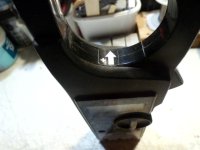I want to adjust the driver's on-board potentiometer with the laser diode already connected - i.e. no test load.
Do most of you simply turn the potentiometer screw a very small amount, turn the power on, measure the current, turn the power off, and continue this process over and over until the desired current?
Note: When turning the tiny screw on the driver's on-board potentiometer, many recommend turning the power off first to avoid excessive noise and current spikes (which can occur during the turning of the tiny screw) which can exceed the laser diode's amp rating and damage it. Also, the current response to the screw turns is not linear and is therefore a bit unpredictable so its better to take your time and turn the screw very small increments at a time if you decide to do this. Needless to day, the lower the laser diode amp rating, the higher the risk of diode damage with this procedure.
Do you use a standard multimeter, and inductive current meter (clamp meter), or something else?
For my specific situation, I am setting a NUBM07E laser diode (specs: max 3.5Amps, nominal 2.3Amps) to 2.3 Amps using a driver pre-set to 1.6 Amps.
Do most of you simply turn the potentiometer screw a very small amount, turn the power on, measure the current, turn the power off, and continue this process over and over until the desired current?
Note: When turning the tiny screw on the driver's on-board potentiometer, many recommend turning the power off first to avoid excessive noise and current spikes (which can occur during the turning of the tiny screw) which can exceed the laser diode's amp rating and damage it. Also, the current response to the screw turns is not linear and is therefore a bit unpredictable so its better to take your time and turn the screw very small increments at a time if you decide to do this. Needless to day, the lower the laser diode amp rating, the higher the risk of diode damage with this procedure.
Do you use a standard multimeter, and inductive current meter (clamp meter), or something else?
For my specific situation, I am setting a NUBM07E laser diode (specs: max 3.5Amps, nominal 2.3Amps) to 2.3 Amps using a driver pre-set to 1.6 Amps.
Last edited:








